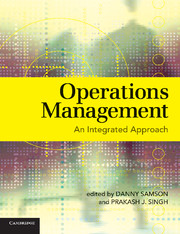Book contents
- Frontmatter
- Contents
- List of Contributors
- Preface
- Acknowledgements
- Part I Operations within Organisations – Building Blocks
- Part II Approaches to Understanding OM
- Part III Moving Forward with OM – Creating Competitive Advantage
- Part IV Challenges and Opportunities in Operations
- Part V Case Studies
- 1 Innovation in the Biotechnology Sector: The Case of IDT Australia
- 2 New Zealand King Salmon: Value-Chain Innovation
- 3 Pilila Clothing Company Goes Lean
- 4 From Singapore to the World: Port Management in Singapore
- 5 Striving for Operations Excellence within Queensland Rail Supply Division
- 6 Should I Stay or Should I Go? Shiraishi Garments Company
- 7 Towards a Green Supply Chain: Toyota Australia
- 8 Process Analyses and Improvement at Bartter Enterprises
- 9 Operations Challenges at Firth Industries Limited, Wellington Division
- 10 Ford Motor Company: Moving Forward in Australia
- 11 Technology Transfer at Hero Honda
- 12 Why Is the Patient Resident Time so Long?: The Case of St Martin's and Charity Private Hospital
- Index
8 - Process Analyses and Improvement at Bartter Enterprises
Published online by Cambridge University Press: 05 June 2012
- Frontmatter
- Contents
- List of Contributors
- Preface
- Acknowledgements
- Part I Operations within Organisations – Building Blocks
- Part II Approaches to Understanding OM
- Part III Moving Forward with OM – Creating Competitive Advantage
- Part IV Challenges and Opportunities in Operations
- Part V Case Studies
- 1 Innovation in the Biotechnology Sector: The Case of IDT Australia
- 2 New Zealand King Salmon: Value-Chain Innovation
- 3 Pilila Clothing Company Goes Lean
- 4 From Singapore to the World: Port Management in Singapore
- 5 Striving for Operations Excellence within Queensland Rail Supply Division
- 6 Should I Stay or Should I Go? Shiraishi Garments Company
- 7 Towards a Green Supply Chain: Toyota Australia
- 8 Process Analyses and Improvement at Bartter Enterprises
- 9 Operations Challenges at Firth Industries Limited, Wellington Division
- 10 Ford Motor Company: Moving Forward in Australia
- 11 Technology Transfer at Hero Honda
- 12 Why Is the Patient Resident Time so Long?: The Case of St Martin's and Charity Private Hospital
- Index
Summary
Phillip Irvine, Operations Director of Bartter Enterprises (Australia's second largest chicken and poultry processor) was sitting in his office in North Ryde, Sydney in June 2006 reflecting on the meeting which had just ended with Geoff Frost, Group CEO, on the strategy for extending the BBX initiative group wide. Without any doubt, the work which Geoff and he had initiated in the Beresfield plant had been extraordinarily successful. Since launch in 2005, it had already delivered verified savings of over $3 m, which would be annualised at over $5 m. The key questions he now had to address were:
How to get this level of change implemented throughout the group?
How to ensure sustainability of this initiative?
How to go beyond this, and embed a culture of continual improvement for the future?
Phillip was not underestimating the challenge of the task ahead. He had just finished reviewing the detailed diagnostic data from the Hanwood, NSW site which had shown that while most of the key themes for change were consistent with Beresfield, the differences in such things as plant layout, skills and work practises suggested that less than 30 per cent of the Beresfield change initiatives would be applicable group wide. He mused therefore that a simple roll out of implemented changes from Beresfield across the whole group was definitely not an option. However, he had not been counting on such a roll out as he believed passionately in the adage – change imposed is change opposed.
- Type
- Chapter
- Information
- Operations ManagementAn Integrated Approach, pp. 490 - 503Publisher: Cambridge University PressPrint publication year: 2008



